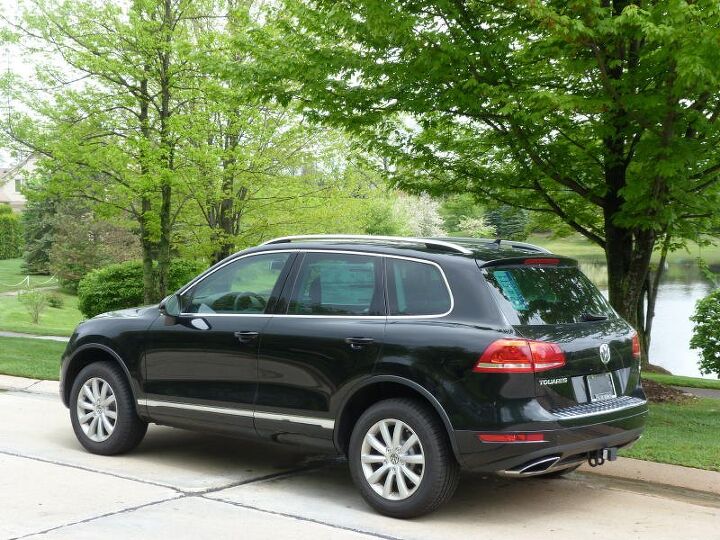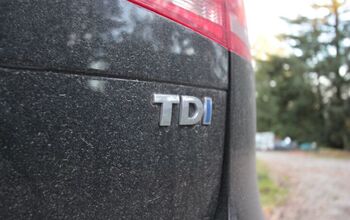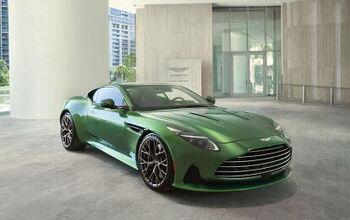Review: 2011 Volkswagen Touareg VR6
How many people would rather have a Volkswagen than a Mercedes? The first-generation Volkswagen Touareg, introduced as a 2004 model, was the product of two unusual events. First, CEO Ferdinand Piech took the brand upmarket (and then some) to challenge Mercedes-Benz—so what if that was Audi’s job. Second, Mercedes, which previously had all but ignored the specific needs of the American market, jumped on the SUV gravy train. So, like BMW, Volkswagen (and Porsche, but that’s next) had to have one, too. Add in some newbie cluelessness concerning how the vehicle would typically be used, and the original Touareg became a luxuriously-outfitted, hyper-complex, 5,000-plus-pound, air-suspended, off-road-capable chunk of a truck with a price tag to match. In subsequent years, VW abandoned its assault on Stuttgart and perhaps learned a thing or two about the SUV market. But would you know it from the redesigned 2011 Touareg?
Exterior styling doesn’t appear to have been a primary consideration with the original Touareg. Quite likely, the engineers developed a body structure then tossed it over the wall to design, which then dressed it as much as possible like other VWs. The various curves and bulges fit together awkwardly, especially around the ends. With the 2011, the exterior is much the same—the typical car buyer probably cannot tell the two apart—but with subtle tweaks that eliminate the earlier awkwardness without adding anything eye-catching or distinctive. As noted in my review of the Q5, the Touareg strongly resembles both the half-size-smaller Audi and the closely-related Porsche Cayenne.
In the retreat from Stuttgart, Volkswagen decontented the interiors of its cars. The new Touareg’s interior doesn’t induce shock and awe like the original’s did (“This is a VW?!”), but remains a cut or two above the others in the showroom. As with the exterior, the new design is cleaner, perhaps to a fault. Though curb weight is down nearly 400 pounds (to a still hefty 4,700) the Touareg retains a tight, solid feel that even the best domestic SUVs (e.g. the new Jeep Grand Cherokee) can’t quite match.
The Germans haven’t yet gotten the memo that Americans want more car-like SUVs (as suggested by the rise of crossovers). So the Touareg’s driving position remains much the same following the redesign, with a high seat behind a large, relatively upright windshield. The leatherette seat itself is a touch mushy and largely devoid of lateral support—both surprises in a VW. Creating some distance from the Porsche? The rear seat slides and reclines. Slide it back and there’s a decent amount of legroom—but no more than in the 14-inch-shorter, 1,100-pound-lighter Tiguan. The two-speed transfer case no longer crosses the Atlantic, but the Touareg’s packaging efficiency remains that of a conventional SUV. To give credit where due, the Touareg’s cabin is a couple inches wider than the Tiguan’s, and it can hold considerably more cargo (70.9 vs. 56.1 cubic feet), with much of the difference behind the second row seat.
The original Touareg’s V8 gas and V10 diesel engines didn’t survive the change in mission. In their places we now get a 333-horsepower supercharged V6 hybrid and a 225-horsepower V6 diesel. But I sampled the third, relatively boring engine choice, the 280-horsepower 3.6-liter narrow-angle VR6, which like the others is now mated to an eight-speed automatic. Aided by the additional ratios and reduced poundage, this engine feels strong once underway (the initial movement from a dead stop won’t snap any necks). The transmission sometimes seems indecisive, but perhaps it was still learning my driving style. The EPA ratings of 16/23 are typical of a midsize SUV. Require better numbers? Then VW has the hybrid (20/24) or the diesel (19/28) for you. Or the Tiguan (21/27).
Unlike every other U.S.-market VW, the Touareg is not based on a front-wheel-drive platform. Instead, the engine and transmission are located much as they are in any given truck, for a 53/47 weight distribution and a more balanced feel than you’ll find in a car-based crossover. Body motions are very well controlled for an SUV, and the ride is generally smooth and quiet, with just a little clomping over tar strips to remind you of its national origin. A height-adjustable air suspension is no longer offered, but won’t be missed as long as you remain on the pavement. And yet, despite the Porsche tie, “fun” is a stretch. The steering is quick, perhaps a little too quick, with some twitchiness at highway speeds, but it’s not communicative. And, let’s face it, this is a tall, heavy vehicle with little in the way of sporting pretensions. The Touareg feels smaller and lighter than it is, but not to a sufficient degree to call the laws of physics into question.
The new Touareg might not aspire to the same heights the original did, but VW has been cutting prices. Well, not in this case. The 2011 I drove, a base trim V6 with only a couple of minor options—the cheap one—listed for $46,005, about $2,800 more than a comparable 2010. This is the price with no leather, no wood, and no sunroof (but with standard nav and xenon headlights). For 2012 nav became optional to enable a $1,475 price cut. Add it back and you’re $545 over the 2011.Such pricing pits the Touareg against some heady competition. The vehicle that started it all, the Mercedes-Benz ML350, has just entered its third generation. To similarly equip a Touareg you need the $5,880 Lux Package (not on the tested vehicle), which bumps the tab to just under fifty. A comparably-equipped Mercedes lists for $7,400 more. Use TrueDelta’s car price comparison tool to adjust for remaining feature differences and compare the two invoice-to-invoice (often a better indicator of what you’ll actually pay), and the gap shrinks to about $4,300. Perhaps you’d rather think of the Touareg as a Cayenne without the Porsche price? The latter will set you back about $8,500 more if you go easy on the options, perhaps $13,000 more otherwise.
The Touareg’s toughest challenge might come from the Jeep Grand Cherokee, which received a substantial upgrade for 2011. Equipped similarly to the tested Touareg, the Jeep runs about $7,800 less before adjusting for feature differences, about $8,700 less afterwards. Until it gets its own eight-speed automatic, the Jeep feels sluggish compared to the VW, and even afterwards (2013?) it should continue to feel heavier and cushier. So it’s not a direct substitute. But the Jeep has its own strengths, and $8,700 is a sizable chunk of change.
The Volkswagen Touareg is certainly a solid, thoroughly competent vehicle, but its construction and consequent price continue to reflect Piech’s “beat Mercedes” ambitions of a decade ago rather than his “beat Toyota” ambitions of today. The Phaeton large luxury sedan is long gone from these shores, but its companion SUV has survived into a second generation. To have the interior ambiance reflect the price tag, you’ve got to spend another $5,880, at which point you’re uncomfortably close to $50,000 and the all-new Mercedes. Rather have a diesel? Then the price difference is cut in half and is hardly worth thinking about. So, how many people would rather have a VW than a Mercedes? Apparently about 500 a month. Odds of a third-generation $50,000+ Touareg in 2018?
Vehicle provided by Dan Kelley, Suburban VW in Farmington Hills, MI, 248-741-7903
Michael Karesh operates TrueDelta.com, an online source of car reliability and pricing information.
Michael Karesh lives in West Bloomfield, Michigan, with his wife and three children. In 2003 he received a Ph.D. from the University of Chicago. While in Chicago he worked at the National Opinion Research Center, a leader in the field of survey research. For his doctoral thesis, he spent a year-and-a-half inside an automaker studying how and how well it understood consumers when developing new products. While pursuing the degree he taught consumer behavior and product development at Oakland University. Since 1999, he has contributed auto reviews to Epinions, where he is currently one of two people in charge of the autos section. Since earning the degree he has continued to care for his children (school, gymnastics, tae-kwan-do...) and write reviews for Epinions and, more recently, The Truth About Cars while developing TrueDelta, a vehicle reliability and price comparison site.
More by Michael Karesh
Latest Car Reviews
Read moreLatest Product Reviews
Read moreRecent Comments
- ToolGuy There was a time when in a place called America there were roads, and they were paved, and they were paved smoothly enough for a vehicle like this. Perhaps our next President will bring back that concept.
- ToolGuy I suppose I will listen before commenting. (TG, what a fair-minded dude!)
- ToolGuy "The technology is much more advanced to be better than a role model driver,”• Do any of you know what a "role model driver" is? No, I guess you wouldn't. 😉
- ToolGuy I might be Batman.
- Lou_BC Well, I'd be impressed if this was in a ZR2. LOL


















































Comments
Join the conversation
I will still take a Volvo XC90 as direct competitor though Volvo is stupid in my opinion not to offer the current T6 as a powertrain; however Volvo is still haunted by the original XC90 T6 GM supplied transmissions premature deaths, call it the XC90 Sport or Premium instead of T6. I think the styling of the XC90 is still more definitive,unique and modern despite being released back in 2003. Plus the XC90 still is able to maintain its status as an IIHS top safety pick despite its age and the introduction of the roof strength test. Plus the inline six isn't a compromised design has been quite durable.
I purchased a new 2011 base model for 42k. The interior is stunning, and I had figured out the media/nav touchscreen system 5 minutes into the test drive (unlike the ridiculous ML). The interior space is considerably greater than a Q5 (a significant difference for tall drivers), the car maneuvers much better than the Q7 (i.e. turning circle). The volvo XC90 handles terribly, and objectively the interior and features are just not as nice. I test drove about every suv on the market, and this one just blew me away. If you have developed a negative opinion of this car without having driven one, my advice to you would be to drive it.